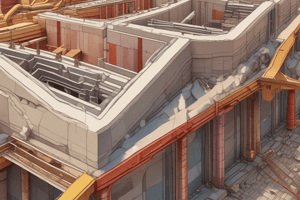Podcast
Questions and Answers
What is the primary material used in batt insulation?
What is the primary material used in batt insulation?
- Foamed plastic
- Cellular glass
- Kraft paper
- Glass or mineral wool (correct)
What is the characteristic of cellular glass insulation?
What is the characteristic of cellular glass insulation?
- Moisture-absorbing
- Fire-resistant (correct)
- High thermal-resistance value
- Flammable
What is the purpose of a vapor retarder in batt insulation?
What is the purpose of a vapor retarder in batt insulation?
- To enhance sound insulation
- To increase the thermal-resistance value
- To prevent moisture migration (correct)
- To provide structural support
What is the characteristic of rigid foam insulation?
What is the characteristic of rigid foam insulation?
What is the advantage of using rigid insulation with a closed-cell structure?
What is the advantage of using rigid insulation with a closed-cell structure?
What is the characteristic of foamed-in-place insulation?
What is the characteristic of foamed-in-place insulation?
What is the primary purpose of thermal insulation in a building?
What is the primary purpose of thermal insulation in a building?
What is the unit of measurement for thermal resistance of a material?
What is the unit of measurement for thermal resistance of a material?
What is the relationship between U-value and R-value?
What is the relationship between U-value and R-value?
What is the primary benefit of thermal insulation in a building?
What is the primary benefit of thermal insulation in a building?
What is the main purpose of controlling the flow of heat through a building's exterior assemblies?
What is the main purpose of controlling the flow of heat through a building's exterior assemblies?
What is the unit of measurement for the rate of heat transfer through a building component or assembly?
What is the unit of measurement for the rate of heat transfer through a building component or assembly?
What is the primary principle followed by the insulation materials discussed in the content?
What is the primary principle followed by the insulation materials discussed in the content?
What is the main reason behind the acoustic insulation of plasterboard walls?
What is the main reason behind the acoustic insulation of plasterboard walls?
What is the function of the air space in the double plasterboard walls?
What is the function of the air space in the double plasterboard walls?
What is the main purpose of building double walls separated by an air space?
What is the main purpose of building double walls separated by an air space?
What type of walls are always double and made up of two or more boards separated by an air space filled with fibrous insulation material?
What type of walls are always double and made up of two or more boards separated by an air space filled with fibrous insulation material?
What is the main advantage of using mixed walls?
What is the main advantage of using mixed walls?
What is the primary purpose of using a 'floating floor' in acoustic insulation?
What is the primary purpose of using a 'floating floor' in acoustic insulation?
What is the ideal solution for inhabited rooms when no other type of action is possible for acoustic insulation?
What is the ideal solution for inhabited rooms when no other type of action is possible for acoustic insulation?
What is the main factor that affects the insulation level of brick walls against airborne noise?
What is the main factor that affects the insulation level of brick walls against airborne noise?
What is the purpose of using FONOSTOPDuo in acoustic insulation of floors?
What is the purpose of using FONOSTOPDuo in acoustic insulation of floors?
What is the advantage of using a screed insulated from the structure in acoustic insulation of floors?
What is the advantage of using a screed insulated from the structure in acoustic insulation of floors?
What is the main purpose of thermal and acoustic insulation systems against foot-traffic noise?
What is the main purpose of thermal and acoustic insulation systems against foot-traffic noise?
What is the primary function of a vapor retarder in a construction?
What is the primary function of a vapor retarder in a construction?
Why are light colors and shiny surfaces preferred in building design?
Why are light colors and shiny surfaces preferred in building design?
What is the significance of the orientation of the exterior surfaces of a building?
What is the significance of the orientation of the exterior surfaces of a building?
Where is the vapor retarder typically placed in a construction in temperate and cold climates?
Where is the vapor retarder typically placed in a construction in temperate and cold climates?
What is the primary benefit of using thermal insulation in buildings?
What is the primary benefit of using thermal insulation in buildings?
What is the impact of the mass of the building assembly on heat loss or gain?
What is the impact of the mass of the building assembly on heat loss or gain?
Flashcards are hidden until you start studying
Study Notes
Thermal Insulation
- Primary purpose: control heat flow through exterior building assemblies to prevent excessive heat loss in cold seasons and heat gain in hot weather
- Reduces energy required by heating and cooling equipment to maintain human comfort in buildings
Materials: R-value and U-value
- R-value: measure of thermal resistance of a material, expressed as temperature difference required to cause heat to flow through a unit area of material at a rate of one heat unit per hour
- U-value: measure of thermal transmittance of a building component or assembly, expressed as rate of heat transfer through a unit area caused by a difference of one degree between air temperatures on two sides of the component or assembly
- U-value is the reciprocal of R-value
Acoustic Insulation of Floors
- Interrupt continuity of structure with soft, flexible materials to stop vibrations (e.g., "floating floor" with FONOSTOPDuo)
- Build screed insulated from structure and floor with any material to localize and contain foot-traffic noise
- Line room with false-ceiling, anti-vibration hooks, and light false-walls in lined plaster and mineral or synthetic wool for ideal solution
Insulation of Foot-Traffic Noise
- Thermal and Acoustic insulation systems: Floating floor
- Wood floor Thermal and Acoustic insulation systems: Floating floor
Thermal and Acoustic Insulation of Walls
- Brick walls: insulation depends on weight; heavier the wall, higher the insulation level (follows law of mass)
- Light walls in plasterboard: dynamic insulation based on resonance effects; uses double boards separated by air space filled with fibrous insulation material
- Mixed walls: combines brick wall and plasterboard wall for a mixed solution
Other Factors Affecting Heat Loss or Gain
- Surface color and reflectivity of materials used
- Mass of the assembly, affecting time lag or delay before absorbed and stored heat is released
- Orientation of exterior surfaces, affecting solar heat gain and air infiltration
- Latent heat sources and heat gain from occupants, lighting, and equipment within a building
- Proper installation of thermal insulation and vapor retarders
Vapor Retarders
- Material of low permeance installed in construction to prevent moisture from entering and condensing
- Placed as close as possible to warm side of insulated construction in temperate and cold climates
- Placed closer to outer face of construction in warm, humid climates
Insulating Materials
- Batt insulation: flexible, fibrous thermal insulation of glass or mineral wool, used in light wood frame construction
- Rigid foam insulation: preformed, nonstructural insulating board of foamed plastic or cellular glass
- Foamed-in-place insulation: foamed plastic sprayed or injected into a cavity, adhering to surrounding surfaces
Studying That Suits You
Use AI to generate personalized quizzes and flashcards to suit your learning preferences.




